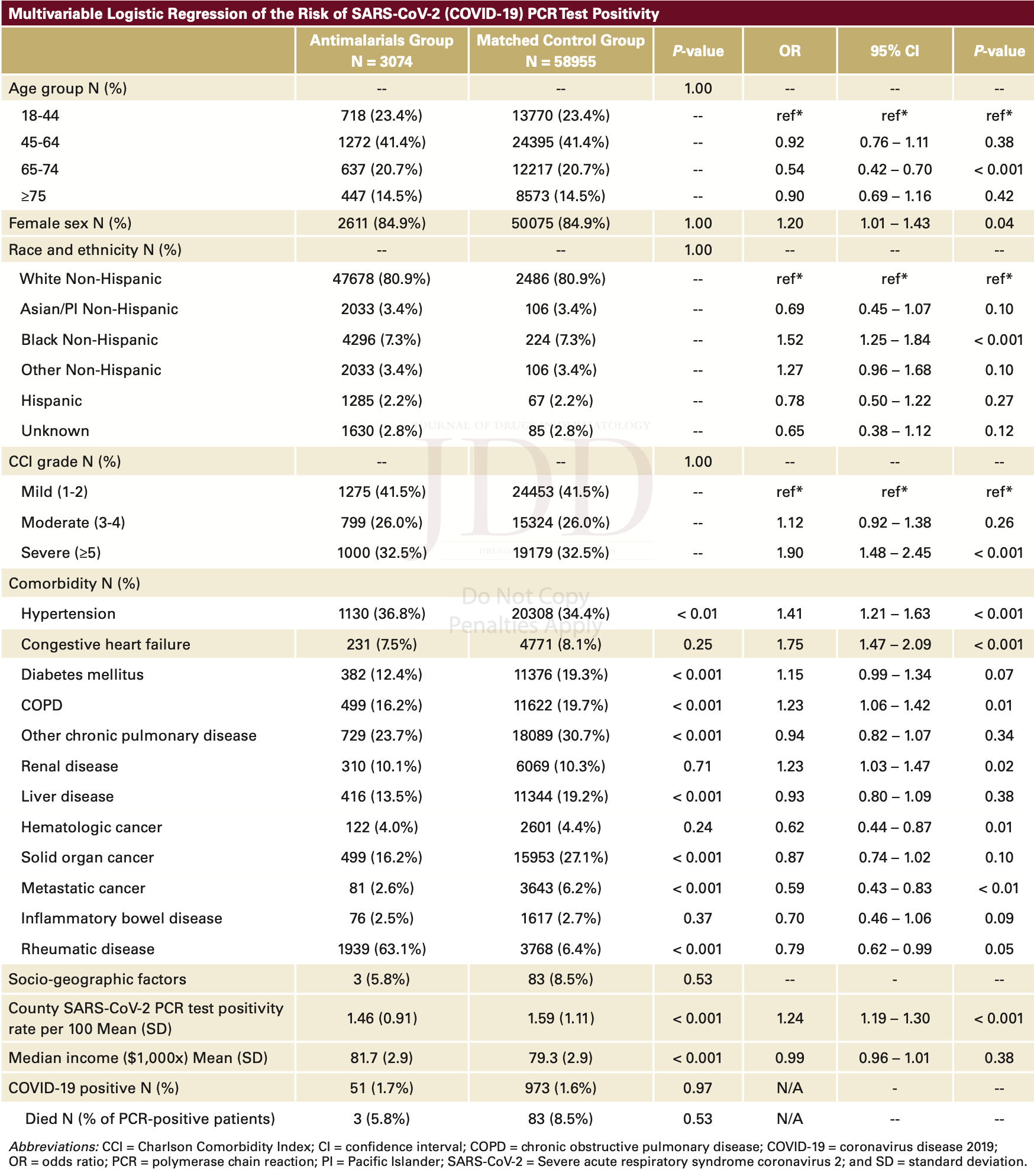Antimalarials are not Effective as Pre-Exposure Prophylaxis for COVID-19: A Retrospective Matched Control Study
MD Nikokai Klebanov, MD MBA Vartan Pahalyants, MD Jordan T Said, William. S Murphy, MD Nicholas Theodosakis, MA Joseph Scarry, Stacey Duey, DDS Monina Klevens, MD Evelyn Lilly, MD Yevgeniy R Semenov
Journal of Drugs in Dermatology, doi:10.36849/jdd.6593
exposure impact on SARS-CoV-2 risk is of great importance to the practicing dermatologist. We investigated the efficacy of antimalarial drugs as pre-exposure SARS-CoV-2 prophylaxis in a US tertiary-care center.
MATERIALS AND METHODS We included all adult patients with at least one prescription for chloroquine, hydroxychloroquine, or quinacrine from July 1, 2019 to February 29, 2020 (limiting prescriptions to those started before the pandemic onset) in the MassGeneral Brigham Enterprise Data Warehouse and Research Patient Data Registry. We exactmatched antimalarial-treated study patients with controls on age, sex, race, and Charleston Comorbidity Index. Additional collected variables included zip codes (used to estimate income using 2010 US Census), and medical history using ICD-9/ICD-10
References
Boulware, Pullen, Bangdiwala, Pastick, Lofgren et al., A randomized trial of hydroxychloroquine as postexposure prophylaxis for Covid-19, N Engl J Med
Carafoli, Chloroquine and hydroxychloroquine in the prophylaxis and therapy of COVID-19 infection
Favalli, Agape, Caporali, Incidence and clinical course of COVID-19 in patients with connective tissue diseases: A descriptive observational analysis, J Rheumatol
Hooijberg, Boekel, Vogelzang, Leeuw, Boers et al., Patients with rheumatic diseases adhere to COVID-19 isolation measures more strictly than the general population, Lancet Rheumatol
Kuderer, Choueiri, Shah, Shyr, Rubinstein et al., Clinical impact of COVID-19 on patients with cancer (CCC19): a cohort study, Lancet
Robinson, Gyawali, Evans, COVID-19 and cancer: do we really know what we think we know?, Nat Rev Clin Oncol
Sanders, Monogue, Jodlowski, Cutrell, Pharmacologic Treatments for Coronavirus Disease 2019 (COVID-19): A Review, JAMA -J Am Med Assoc
Schreiber, Sciascia, Bruce, Giles, Cuadrado et al., Hydroxychloroquine in patients with rheumatic diseases during the COVID-19 pandemic: a letter to clinicians, Lancet Rheumatol
DOI record:
{
"DOI": "10.36849/jdd.6593",
"ISSN": [
"1545-9616"
],
"URL": "http://dx.doi.org/10.36849/jdd.6593",
"author": [
{
"affiliation": [],
"family": "Klebanov",
"given": "Nikokai",
"sequence": "first"
},
{
"affiliation": [],
"family": "Pahalyants",
"given": "Vartan",
"sequence": "additional"
},
{
"affiliation": [],
"family": "Said",
"given": "Jordan T.",
"sequence": "additional"
},
{
"affiliation": [],
"family": "Murphy",
"given": "William. S.",
"sequence": "additional"
},
{
"affiliation": [],
"family": "Theodosakis",
"given": "Nicholas",
"sequence": "additional"
},
{
"affiliation": [],
"family": "Scarry",
"given": "Joseph",
"sequence": "additional"
},
{
"affiliation": [],
"family": "Duey",
"given": "Stacey",
"sequence": "additional"
},
{
"affiliation": [],
"family": "Klevens",
"given": "Monina",
"sequence": "additional"
},
{
"affiliation": [],
"family": "Lilly",
"given": "Evelyn",
"sequence": "additional"
},
{
"affiliation": [],
"family": "Semenov",
"given": "Yevgeniy R.",
"sequence": "additional"
}
],
"container-title": "Journal of Drugs in Dermatology",
"container-title-short": "JDD",
"content-domain": {
"crossmark-restriction": false,
"domain": []
},
"created": {
"date-parts": [
[
2023,
8,
9
]
],
"date-time": "2023-08-09T17:55:51Z",
"timestamp": 1691603751000
},
"deposited": {
"date-parts": [
[
2023,
8,
9
]
],
"date-time": "2023-08-09T17:56:17Z",
"timestamp": 1691603777000
},
"indexed": {
"date-parts": [
[
2023,
8,
10
]
],
"date-time": "2023-08-10T04:31:28Z",
"timestamp": 1691641888059
},
"is-referenced-by-count": 0,
"issue": "8",
"issued": {
"date-parts": [
[
2023,
7,
1
]
]
},
"journal-issue": {
"issue": "8",
"published-online": {
"date-parts": [
[
2023,
7,
1
]
]
},
"published-print": {
"date-parts": [
[
2023,
8,
1
]
]
}
},
"member": "22713",
"original-title": [],
"page": "840-843",
"prefix": "10.36849",
"published": {
"date-parts": [
[
2023,
7,
1
]
]
},
"published-online": {
"date-parts": [
[
2023,
7,
1
]
]
},
"published-print": {
"date-parts": [
[
2023,
8,
1
]
]
},
"publisher": "SanovaWorks",
"reference-count": 0,
"references-count": 0,
"relation": {},
"resource": {
"primary": {
"URL": "https://jddonline.com/articles/dermatology/S1545961623P0840X"
}
},
"score": 1,
"short-title": [],
"source": "Crossref",
"subject": [
"General Medicine"
],
"subtitle": [],
"title": "Antimalarials are not Effective as Pre-Exposure Prophylaxis for COVID-19: A Retrospective Matched Control Study",
"type": "journal-article",
"volume": "22"
}
